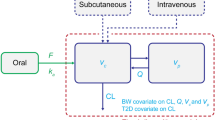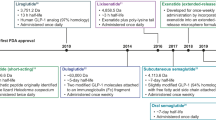Abstract
Purpose
The study was designed to evaluate the effect of delayed release (DR) on absorption and bioavailability of intestinally metabolized drugs after oral dosing, using the HMG-CoA reductase inhibitor simvastatin, a CYP3A substrate, as a model drug.
Materials and Methods
To target drug release and to assess regional gastrointestinal absorption of the CYP 3A substrate simvastatin from the distal parts of the intestine, delayed release film coated tableted oral dosage forms were developed. Simvastatin delayed release tablet, simvastatin immediate release capsule and simvastatin immediate release tablet Zocor® were administered as single doses (20 mg) to fasting healthy volunteers in a crossover design.
Results
Simvastatin bioavailability was increased by a factor of three, as compared to the reference formulation Zocor®. The overall metabolite levels from the immediate release capsules tended to be higher throughout the period studied than the metabolite levels following administration of Zocor® and simvastatin delayed release dosage form.
Conclusions
The interplay between gastrointestinal physiology (lower CYP 3A expression in the distal ileum and the colon) and formulation design (zero-order controlled release after a predetermined lag-time) resulted in successful absorption and bioavailability improvement and represent a viable strategy to reduce the dose of CYP 3A drugs.





Similar content being viewed by others
References
P. Watkins. Drug metabolism by cytochromes P450 in the liver and small bowel. Gastroenterol. Clin. North Am. 21:511–526 (1992).
Q. Zhang, D. Dunbar, A. Ostrowska, S. Zeisloft, J. Yang, and L. Kaminsky. Characterization of human small intestinal cytochromes P-450. Drug Metab. Dispos. 27:804–809 (1999).
R. McKinnonand, and M. McManus. Localization of cytochromes P450 in human tissues: Implications for chemical toxicity. Pathology 28:148–155 (1996).
M. Thorn, N. Finnstrom, S. Lundgren, A. Rane, and L. Loof. Cytochromes P450 and MDR1 mRNA expression along the human gastrointestinal tract. Br. J. Clin. Pharmacol. 60:54–60 (2005).
O. von Richter, O. Burk, M. Fromm, K. Thon, M. Eichelbaum, and K. Kivistö. Cytochrome P450 3A4 and P-glycoprotein expression in human small intestinal enterocytes and hepatocytes: a comparative analysis in paired tissue specimens. Clin. Pharmacol. Ther.172–183 (2004).
A. Basit. Advances in colonic drug delivery. Drugs 65:1991–2007 (2005).
D. R. Friend. Oral colon-specific drug delivery, CRC Press, Boca Raton, FL, 1992.
G. Patel. Oral colon-specific drug delivery: an overview. Drug Delivery Techno. 6:62–71 (2006).
G. Amidon and J. Crison. Water soluble pharmaceutical coating and method for producing coated pharmaceuticals, US Patent, 1998.
T. Prueksaritanont, B. Ma, and N. Yu. The human hepatic metabolism of simvastatin hydroxy acid is mediated primarily by CYP3A, and not CYP2D6. Br. J. Clin. Pharmacol. 56:120–124 (2003).
A. Tornio, M. Pasanen, J. Laitila, P. Neuvonen, and J. Backman. Comparison of 3-hydroxy-3-methylglutaryl Coenzyme A (HMG-CoA) reductase inhibitors (statins) as inhibitors of cytochrome P450 2C8. Basic Clin. Pharmacol. Toxicol. 97:104–108 (2005).
C. Transon, T. Leemann, and P. Dayer. In vitro comparative inhibition profiles of major human drug metabolising cytochrome P450 isozymes (CYP2C9, CYP2D6 and CYP3A4) by HMG-CoA reductase inhibitors. Eur. J. Clin. Pharmacol. 50:209–215 (1996).
T. Prueksaritanont, R. Subramanian, X. Fang, M. Bennett, Y. Qiu, J. Lin, P. Pearson, and T. Baillie. Glucuronidation of statins in animals and humans: a novel mechanism of statin lactonization. Drug Metab. Dispos. 30:505–512 (2002).
J. Hilfinger, J. Kim, and P. Kijek. Methods and composition of extended delivery of water insoluble drugs. In U. P. A. Publication (ed.) (U. P. A. Publication, ed.), USA, 2005.
L. Schmuff. HPLC Method for Pharmaceutical Analysis. John Willey & Sohns, New York, 1997.
J. Zhao, I. H. Xie, A. Yang, B. Roadcap, and J. Rogers. Quantitation of simvastatin and its ß-hydroxy acid in human plasma by liquid–liquid cartridge extraction and liquid chromatography/tandem mass spectrometry. J. Mass Spectrom. 35:1133–1143 (2000).
G. Heinzel, R. Woloszczak, and P. Thomann. TopFit, Version 2.0: Pharmacokinetic and pharmacodynamic data analysis system for the PC, G. Fischer: VCH Publishers, 1993.
M. Gibaldi, and D. Perrier. Pharmacokinetics. Marcel Dekker, New York, 1982.
I. Mahmood. Pharmacokinetic analysis of the absorption characteristics of diclofenac sodium in man by use of a multi-segment absorption model. J. Pharm. Pharmacol. 48:1260–1263 (1996).
H. Cheng, J. Rogers, A. Sweany, M. Dobrinska, E. Stein, A. Tate, R. Amin, and H. Quan. Influence of age and gender on the plasma profiles of 3-hydroxy-3-methylglutaryl-Coenzyme A (HMG-CoA) reductase inhibitory activity following multiple doses of lovastatin and simvastatin. Pharm. Res. 9:1629–1633 (1992).
M. Kaufman. Applications of oxygen polarography to drug stability testing and formulation development: solution-phase oxidation of hydroxymethylglutaryl Coenzyme A (HMG-CoA) reductase inhibitors. Pharm. Res. 7:289–292 (1990).
M. Ozyazici, E. Gokce, and G. Ertan. Release and diffusional modeling of metronidazole lipid matrices. Eur. J. Pharm. Biopharm. 63:331–339 (2006).
V. Jannin, E. Pochard, and O. Chambin. Influence of poloxamers on the dissolution performance and stability of controlled-release formulations containing Precirol ATO 5. Int. J. Pharm. 309:6–15 (2006).
M. Savolainen, C. Khoo, H. Glad, C. Dahlqvist, and A. Juppo. Evaluation of controlled-release polar lipid microparticles. Int. J. Pharm. 244:151–161 (2002).
P. Parab, C. Oh, and W. Ritschel. Sustained release from Precirol (glycerol palmito-stearate) matrix: effect of mannitol and hydroxypropyl methylcellulose on the release of theophylline. Drug Dev. Ind. Pharm. 12:1309–1327 (1986).
M. Savolainen, J. Herder, C. Khoo, K. Lovqvist, C. Dahlqvist, H. Glad, and A. Juppo. Evaluation of polar lipid-hydrophilic polymer microparticles. Int. J. Pharm. 262:47–62 (2003).
J. Sousa, A. Sousa, M. Moura, F. Podczeck, and J. Newton. The influence of core materials and film coating on the drug release from coated pellets. Int. J. Pharm. 233:111–122 (2002).
H. Stevens, C. Wilson, P. Welling, M. Bakhshaee, J. Binns, A. Perkins, M. Frier, E. Blackshaw, M. Frame, and D. Nichols. Evaluation of Pulsincap to provide regional delivery of dofetilide to the human GI tract. Int. J. Pharm. 236:27–34 (2002).
D. Bailey, J. Kreeft, C. Munoz, D. Freeman, and J. Bend. Grapefruit juice-felodipine interaction: Effect of naringin and 6. ,7. -dihydroxybergamottin in humans. Clin. Pharmacol. Ther. 64:284–256 (1998).
A. Kashuba, J. J. Bertino, M. Rocci, R. Kulawy, D. Beck, and A. Nafziger. Quantification of 3-month intraindividual variability and the influence of sex and menstrual cycle phase on CYP3A activity as measured by phenotyping with intravenous midazolam. Clin. Pharmacol. Ther. 64:269–277 (1998).
E. Kharasch, M. Russell, K. Garton, G. Lentz, T. Bowdle, and K. Cox. Assessment of cytochrome P450 3A4 activity during the menstrual cycle using alfentanil as a noninvasive probe. Anesthesiology 87:26–35 (1997).
J. Scavone, D. Greenblatt, A. Locniskar, and R. Shader. Alprazolam pharmacokinetics in women on low-dose oral contraceptives. J. Clin. Pharmacol. 28:454–457 (1988).
G. Stoehr, P. Kroboth, R. Juhl, D. Wender, J. Phillips, and R. Smith. Effects of oral contraceptives on trizolam, temazepam, alprazolam, and lorazepam kinetics. Clin. Pharmacol. Ther. 36:683–690 (1984).
H. Lennernäs, and C. Regardh. Evidence for an interaction between the beta-blocker pafenolol and bile salts in the intestinal lumen of the rat leading to dose-dependent oral absorption and double peaks in the plasma concentration-time profile. Pharm. Res. 10:879–883 (1993).
M. Flash-Ner-Barak, I. Lerner, V. Rosenberger, and N. Moldavski. Simvastatin formulations and methods of making same. In T. p. i. ltd. (ed.), Vol. WO 2005/044254 A1 (T. p. i. ltd., ed.), Israel, 2005, pp. 1–32.
T. N. Tozerand, and M. Rowland. Introduction to Pharmacokinetics and Pharmacodynamics: The Quantitative Basis of Drug Therapy. Lippincott Williams & Wilkins, USA, 2006.
J. Kolars, K. Lown, P. Schmiedlin-Ren, M. Ghosh, C. Fang, S. Wrighton, R. Merion, and P. Watkins. CYP3A gene expression in human gut epithelium. Pharmacogenetics 4:247–259 (1994).
O. Mousa, D. Brater, K. Sundblad, and S. Hall. The interaction of diltiazem with simvastatin. Clin. Pharmacol. Ther. 67:267–274 (2000).
K. Thummel, D. O’Shea, M. Paine, D. Shen, K. Kunze, J. Perkins, and G. Wikinson. Oral first-pass elimination of midazolam involves both gastrointestinal and hepatic CYP3A-mediated metabolism. Clin. Pharmacol. Ther. 59:491–502 (1996).
J. Lilja, K. Kivisto, and P. Neuvonen. Grapefruit juice-simvastatin interaction: effect on serum concentrations of simvastatin, simvastatin acid, and HMG-CoA reductase inhibitors. Clin. Pharmacol. Ther. 64:477–483 (1998).
H. Benameur, V. Jannin, and D. Roulot. Method and formulation for decreasing statin metabolism. In F. Gattefosse Holding (ed.), Vol. US 6,652,865 B2 (F. Gattefosse Holding, ed.), USA, 2003.
W. Homsy, G. Caille, and P. du Souich. The site of absorption in the small intestine determines diltiazem bioavailability in the rabbit. Pharm. Res. 12:1722–1726 (1995).
M. Pasanen, M. Neuvonen, P. Neuvonen, and M. Niemi. SLCO1B1 polymorphism markedly affects the pharmacokinetics of simvastatin acid. Pharmacogenetics and Genomics 16:873–879 (2006).
M. Davidson. A look to the future: new treatment guidelines and a perspective on statins. Am. J. Med. 112 (Suppl 8A):34S–41S (2002).
M. Davidson, P. Lukacsko, J. Sun, G. Phillips, E. Walters, A. Sterman, R. Niecestro, and L. Friedhoff. A multiple-dose pharmacodynamic, safety, and pharmacokinetic comparison of extended- and immediate-release formulations of lovastatin. Clin. Ther. 24:112–125 (2002).
B. Hamelinand, and J. Turgeon. Hydrophilicity/lipophilicity:relevance for the pharmacology and clinical effects of HMG-CoA reductase inhibitors. TiPS 19:26–37 (1998).
T. Sawada, K. Sako, K. Yoshihara, K. Nakamura, S. Yokohama, and M. Hayashi. Timed-release formulation to avoid drug–drug interaction between diltiazem and midazolam. J. Pharm. Sci. 92:790–797 (2003).
Acknowledgements
The authors wish to thank Dr. Elke Lipka, TSRL Inc. for kindly revising the manuscript and Ute Hartung, Johannes Gutenberg-University Mainz, for helpful technical assistance.
Author information
Authors and Affiliations
Corresponding author
Rights and permissions
About this article
Cite this article
Tubic-Grozdanis, M., Hilfinger, J.M., Amidon, G.L. et al. Pharmacokinetics of the CYP 3A Substrate Simvastatin following Administration of Delayed Versus Immediate Release Oral Dosage Forms. Pharm Res 25, 1591–1600 (2008). https://doi.org/10.1007/s11095-007-9519-6
Received:
Accepted:
Published:
Issue Date:
DOI: https://doi.org/10.1007/s11095-007-9519-6




